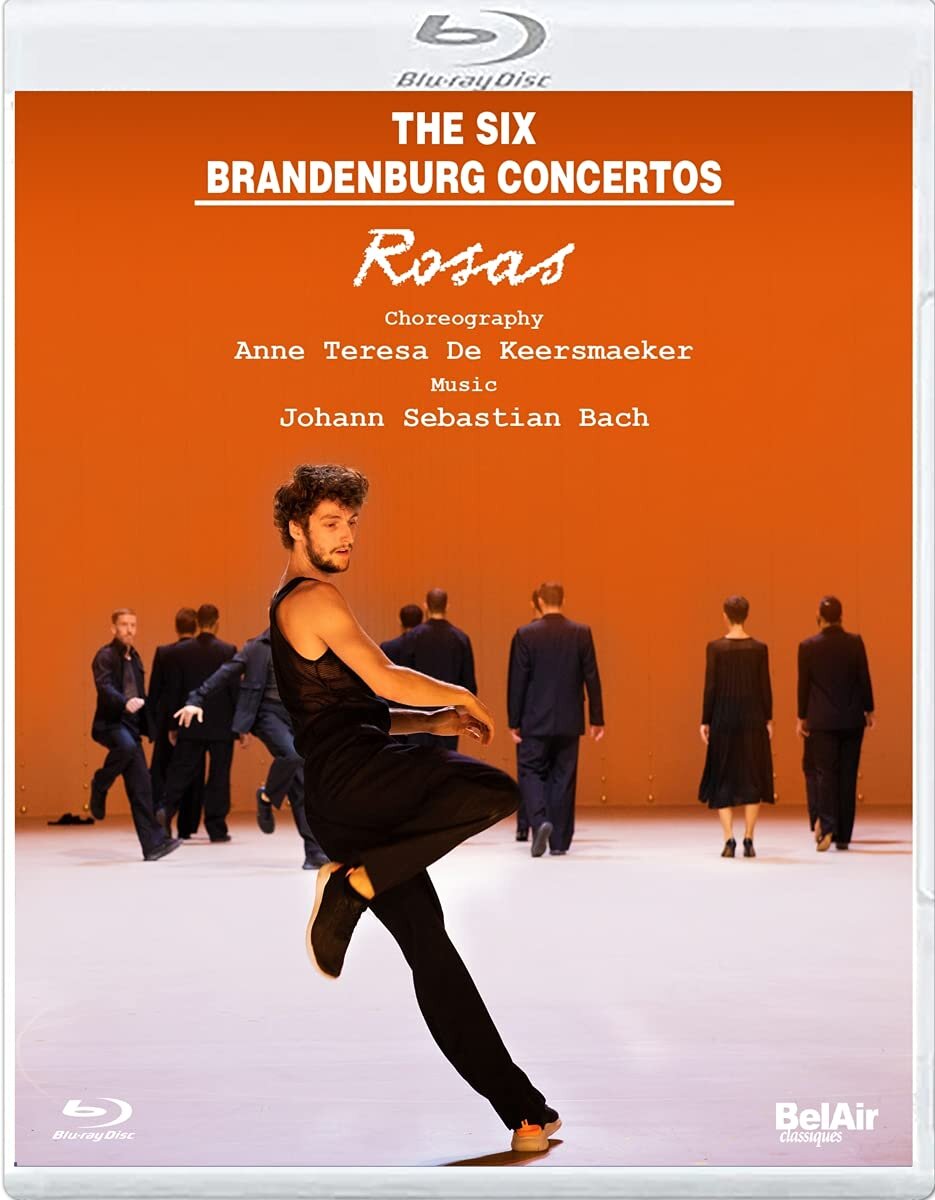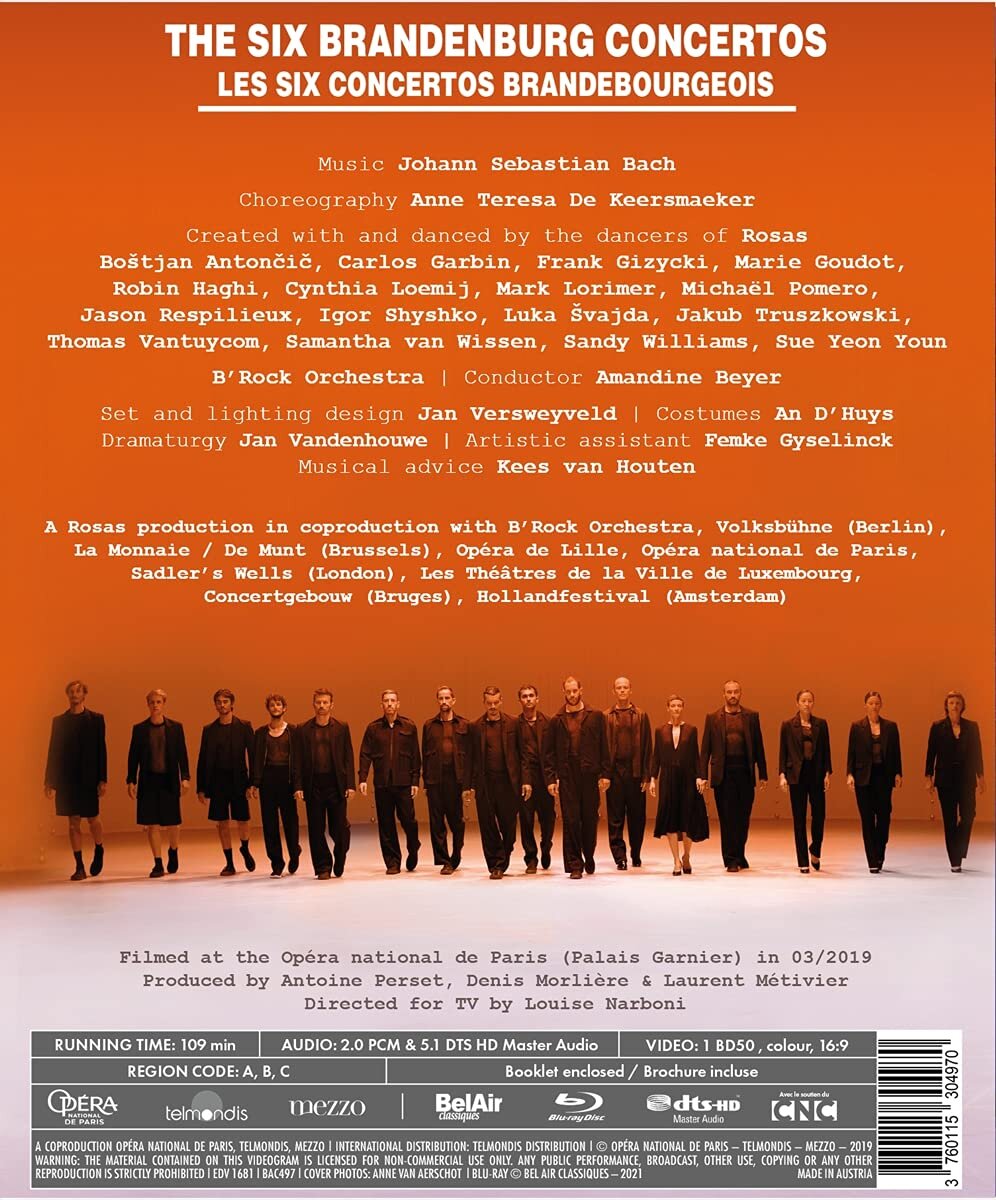

The Six Brandenburg Concertos dance recital choreographed by Anne Teresa De Keersmaeker to JS Bach’s famous music. Performed 2019 at the Opéra national de Paris (Palais Garnier). Created with and performed by the dancers of Rosas, including Boštjan Antončič, Carlos Garbin, Frank Gizycki, Marie Goudot, Robin Haghi, Cynthia Loemij, Mark Lorimer, Michaël Pomero, Jason Respilieux, Igor Shyshko, Luka Švajda, Jakub Truszkowski, Thomas Vantuycom, Samantha van Wissen, Sandy Williams, and Sue Yeon Youn. Amandine Beyer conducts the B’Rock Orchestra. Set and lighting design by Jan Versweyveld; costumes by An D’Huys; dramaturgy by Jan Vandenhouwe; artistic assistant was Femke Gyselinck; musical advice by Kees van Houten. Directed for TV by Louise Narboni. Produced by Antoine Perset, Denis Morlière, and Laurent Métivier. Released 2021, disc has 5.1 dts-HD Master Audio sound. Grade: B-
It appears Anne Teresa De Keersmaeker is unusual as a choreographer in that she never trained in someone else’s dance company. She was a music student who took some dance courses. She was from the beginning a universal genius interested in all the stage arts and mathematics. Like Athena springing from the head of Zeus, she jumped directly into contemporary flat foot dancing at age 20 and was making dances with her own company (Rosas) at age 23! At age 32, she was resident at De Munt/La Monnaie directing operas and creating large dance pieces. She continued to dance throughout her career. For proof see the recent YouTube video below of De Keersmaeker dancing solo at age 62:
Unlike many choreographers, De Keersmaeker likes to dance to the beat. And, according to expert reviewers who saw Six Brandenburg Concertos live, she even assigns dancers to follow what individual musicians in the orchestra are doing. This is intriguing as the musical forces in each of the six concertos vary tremendously. The origin of these short but monumental works is lost in time. But it seems obvious to me that Bach composed each concerto for whatever musicians happened to be available when it was time to write something. Well, all the concertos are played loud and fast, which suits the hard-driving De Keersmaeker.
Being a musician and choreographer, De Keersmaeker devotes almost 15% of this dance video to the B’Rock Orchestra. She takes the six pieces in their number order. Below left, the lady in the center (behind the cembalo) with the flower in her hair is the conductor, Amandine Beyer. Below right you see 3 baroque oboes, so this is Concerto No. 1:
Next below is a close-up of Andreas Küppers on cembalo:
De Keersmaeker has a distinct style of choreography based on mathematically guided formations that have some similarity to sports or exercise events. But she also provides opportunity for individual dancers to engage in wild improvisation. Imagine Mark Morris merged with Gaga. She has a close relationship with the Paris Opera Ballet folks who let her bring her own dancers to town. See our reviews on Rain, which we liked a lot, and and Così fan tutte, which got too complicated for us with Mozart’s opera music and tricky plot added to the mix.
Next below is the opening of the show with the entire cast moving downstage following Anne’s dictum that “My walking is my dancing.” Many of the dancers have been with Anne for a long time. The men tend to be rugged—even swarthy. Only 4 of the dancers are women. They seem to be veterans worn smooth by the passage of time and fast approaching retirement:
The walking around seems almost happenstance. But the dancers must remember and count a lot to make steps in unison. That’s the geometric aspect of De Keersmaeker’s style. Then the patterns are broken up with small groups or solos improvising:
The tabula rasa look:
No sets, props, or narrative. But Anne throws in a dog you keep you off balance. Unfortunately, this dog this time wanted to bark a lot, which did not blend in well with Bach’s music:
In Concerto No. 2 we see Anne is not afraid to turn her back on the audience:
Next below is the band is configured for Concerto No. 3 with three violins, three violas, and three cellos plus cembalo and violone (like today’s double bass). That’s 11 instruments in all:
Guess what! There are also 11 men dancing on stage. Here we mostly get the men running around in various formations following the dictum, “My running is my dancing.”
Two women appear in Concert No. 4. If you watch the disc, try to tell if the dancing of the women relates directly to the two recorders in the pit:
Much of this show is unisex except when the women get several lifts:
Louise Naboni throws in some nice close-ups:
In Concerto No. 5 the stage looks pretty empty with only a handful of dancers onstage:
Next below an unusual closeup. What you see here is the beard on the bottom of the dancer’s chin:
Concerto No. 6 has to serve as the finale, so all the dancers seem to get into the act. The stage at Palais Garnier is really big!
But now the choreography loosens up and the dancers are inspired to show how they can impress you with their distinct personalities:
The “B” in B’Rock stands for Baroque, Belgium, Brussels, Band, and Brotherhood. The band is a co-op without a permanent conductor. They stress green practices, especially for traveling to gigs. It’s a nice touch to get the band out of the pit for a curtain call. The large audience was enthusiastic. It must have been a thrill for the musicians to look out at all the cheering people in the magnificent Garnier auditorium:
This rather austere and cerebral show is probably not all that suitable for viewers just starting to enjoy ballet. SQ and PQ are fine. I ran the numbers for video content on a sample of half the concertos. Narboni only shows the entire bodies of the dancers in a about half of her video segments. Her pace is also too fast, which implies the dread malady of DVDitis. This title has a decent booklet, but it’s written in a typewriter font. Looks cheap. But then I discovered De Keersmaeker uses the same typewriter font on her website! Don’t mess with Anne Teresa!
Based on the dry choreography, the aging dancers, and weak video content, I would have to give this a C. But wait! You also get with this a complete performance of all the Brandenburg Concertos. I compared the music here to our Blu-ray of all these concertos played Abaddo and the Orchestra Mozart in 2007 (on mostly modern instruments). About the same. Since I give the Orchestra Mozart an A, I’ll have to move the grade here up to B-. Call it a fine concert with ballet obligato.
We now have three Blu-rays from De Keersmaeker—but none with an exciting grade. There are lots of Internet videos about De Keersmaeker’s works that are fun to watch and shorter than her projects with the Paris Opera Ballet. She even got into a kind of dance battle with Beyoncé. I hope Anne will one day publish some kind of anthology of her lesser works in Blu-ray (with better PQ and SQ that we get on the web).
OR




















